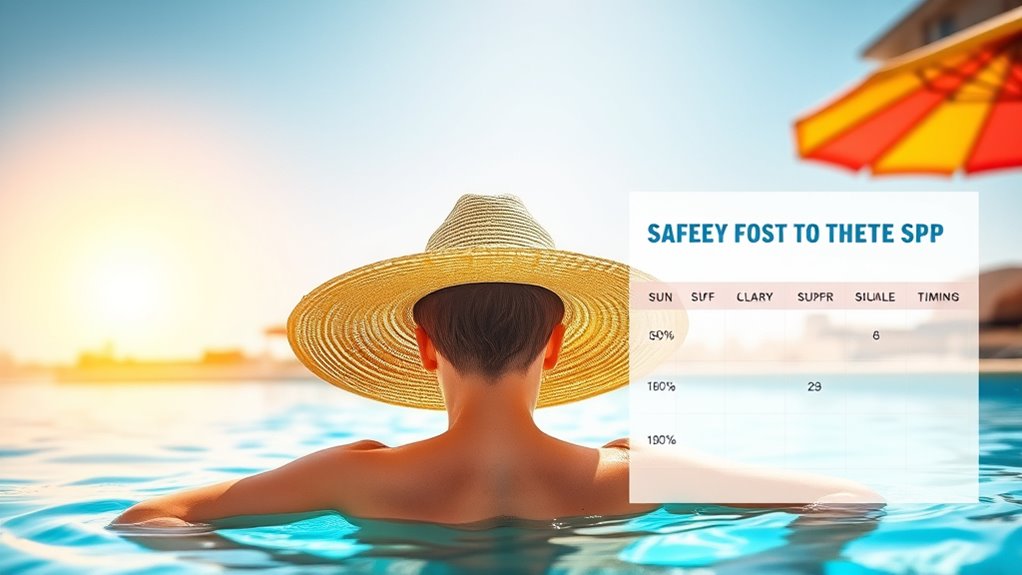To stay safe while swimming, seek shaded areas like umbrellas or natural tree shade, especially during peak sunlight hours. Use broad-spectrum SPF 30+ sunscreen, applying it generously 15-30 minutes beforehand and reapplying every two hours, especially after swimming or sweating. Timing your swim sessions early in the morning or late in the afternoon keeps UV exposure lower. Keep exploring ways to protect your skin effectively and enjoy your time in the water safely.
Key Takeaways
- Seek shaded areas like pavilions, umbrellas, or natural tree cover to reduce UV exposure during swimming.
- Apply broad-spectrum SPF 30+ sunscreen 15-30 minutes before swimming and reapply every two hours and after water exposure.
- Use water-resistant sunscreens and focus on often-missed spots like ears, back of neck, and feet for full protection.
- Plan outdoor swims during early morning or late afternoon when UV rays are less intense for enhanced skin safety.
- Combine shade, proper sunscreen use, and timing to maximize sun protection during swimming activities.
Choosing the Right Shade Options for Swimming Enthusiasts

When it comes to protecting your skin while swimming, choosing the right shade options is essential. Shade provides a reliable barrier against harmful UV rays, especially during peak sunlight hours. Look for shaded areas like pavilions, umbrellas, or natural shade from trees. Portable shade structures are convenient if you’re at a beach or poolside frequently. When selecting a shade, consider its height and coverage area to ensure you’re fully protected. Be mindful that some materials, like canvas or certain fabrics, offer better UV protection than others. Always check if the shade blocks UV rays effectively—this info is usually labeled. Incorporating UV protection into your shade choice can further reduce sun damage. By choosing the right shade options, you minimize sun exposure and keep your skin safe during your swimming adventures.
Effective Sunscreen Use and Application Tips

Even with shaded areas providing some protection, applying sunscreen correctly is key to preventing sun damage while swimming. To maximize effectiveness, start with clean, dry skin. Use a broad-spectrum sunscreen with at least SPF 30, and apply generously 15-30 minutes before swimming. Don’t forget often-missed spots like ears, the back of your neck, and the tops of your feet. Reapply every two hours, or immediately after swimming, towel drying, or sweating. Keep these tips in mind:
Apply sunscreen generously 15-30 minutes before swimming, reapply after swimming or sweating, and don’t forget tricky spots like ears and feet.
- Use enough sunscreen to cover all exposed skin thoroughly
- Apply in two layers for better coverage
- Reapply promptly after swimming or sweating
- Choose water-resistant formulas for lasting protection
- Understanding contrast ratio helps you select sunscreens that maintain protective efficacy under different lighting conditions.
Following these steps helps ensure your skin stays protected during your swim.
Timing Your Outdoor Swim Sessions for Maximum Sun Safety

To maximize your sun safety during outdoor swims, plan your sessions during the early morning or late afternoon hours when the sun’s rays are less intense. These times reduce your risk of sunburn and UV damage. Imagine a typical day: in the morning, the sun rises softly, casting gentle light; at noon, it’s blazing overhead; in the late afternoon, the sun dips low again. Visualize this:
| Time of Day | Sun Intensity | UV Exposure Risk |
|---|---|---|
| Early Morning | Low | Minimal |
| Midday | High | Very High |
| Late Afternoon | Moderate | Reduced |
| Evening | Very Low | Negligible |
Choosing your swim time wisely helps protect your skin while still enjoying the water. Additionally, applying broad-spectrum SPF sunscreen before heading out provides an extra layer of defense against harmful UV rays.
Frequently Asked Questions
How Often Should I Reapply Sunscreen During Swimming?
You should reapply sunscreen every two hours when swimming, even if it’s labeled water-resistant. If you’re sweating heavily or toweling off, reapply sooner to guarantee continuous protection. Make sure to cover all exposed skin thoroughly, including often-missed spots like your ears, back of neck, and feet. Remember, reapplying helps maintain effective SPF levels, preventing sunburn and skin damage during your swim.
What Are the Best Clothing Options for Sun Protection?
Think of sun-protective clothing as your personal shield, blocking harmful rays like a fortress. Opt for long-sleeved shirts made of tightly woven fabrics, wide-brimmed hats, and UV-protective sunglasses. Lightweight, breathable materials keep you cool while guarding your skin. Look for clothing with UPF labels, ensuring maximum protection. Dress smartly to stay safe, comfortable, and shielded from the sun’s relentless rays during your swim or outdoor activities.
Can Swimming in Chlorinated Water Affect Sunscreen Effectiveness?
Yes, swimming in chlorinated water can reduce your sunscreen’s effectiveness. Chlorine breaks down the active ingredients in many sunscreens, making them less protective over time. To stay safe, apply a water-resistant sunscreen generously before swimming, and reapply immediately after getting out of the pool. Using a broad-spectrum, waterproof sunscreen can also help maintain protection despite exposure to chlorinated water.
How Does Water Reflection Increase Sun Exposure Risk?
Water reflection can substantially increase your sun exposure risk because it amplifies UV rays reaching your skin. When you’re at the pool or beach, sunlight bounces off the water’s surface, intensifying UV exposure from multiple angles. This means even if you’re in the shade or wearing sunscreen, you’re still vulnerable to harmful rays. To protect yourself, reapply SPF regularly, seek shade, and wear protective clothing.
Are There Specific Sun Safety Tips for Competitive Swimmers?
You should prioritize wearing a broad-spectrum waterproof SPF 50+ sunscreen before training, even if you think it’s unnecessary. Additionally, you can minimize sun damage by scheduling outdoor practice sessions during early mornings or late afternoons when UV rays are less intense. Don’t forget to wear protective gear like a wide-brimmed hat and UV-protective sunglasses, and take frequent breaks in shaded areas to stay safe during long outdoor swims.
Conclusion
By embracing thoughtful shade, diligent sunscreen, and smart timing, you create a gentle shield against the sun’s harsh rays. These small choices weave a quiet comfort into your swimming routine, allowing you to enjoy every splash and stroke without worry. Remember, protecting your skin is a tender act of self-care—kindness that keeps your love for the water flowing smoothly. Cherish these moments, and let your days in the sun be as safe as they are joyful.








